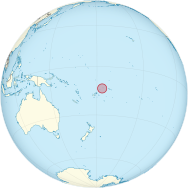Wallis and Futuna is a French overseas collectivity in Polynesia in the Pacific Ocean.[1] It consists of three main islands, Wallis (Uvea), Futuna, and Alofi, along with several offshore islets. These islands have a total land area of 145 km2 (56 sq mi) and are outside the three main archipelagoes in Western Polynesia: Fiji, Samoa, and Tonga.[1][2] There are 62 species of birds that have been recorded from Wallis and Futuna, out of which five have been introduced by humans. No species are endemic to the collectivity, but there are endemic subspecies of the collared kingfisher, Polynesian triller, Fiji shrikebill, and Polynesian starling.[3] The shy ground dove has been extirpated from the islands, while the blue-crowned lorikeet is locally extinct on Uvea.[4] A now-extinct imperial pigeon, Ducula david, was described from subfossil remains on the islands and is thought to have been widespread before the arrival of humans.[5]
Uvea is an eroded volcanic island and the largest of the three, while Futuna and Alofi are composite islands made of volcanic rock and limestone.[2] The latter two islands are only 1.7 km (1.1 mi) from each other, but over 230 km (140 mi) southwest of Uvea.[1] The main vegetation types found in Wallis and Futuna are wetlands such as mangroves and swamp forests, coastal strand vegetation, coastal forests, littoral forests, lowland rainforests, montane rainforests and cloud forests, and human-altered vegetation like secondary forests and cultivation.[6] Threats to the avifauna of the islands include deforestation caused by agriculture, introduced species, especially rats, and hunting.[7]
This list's taxonomic treatment (designation and sequence of orders, families and species) and nomenclature (common and scientific names) follow the conventions of the 2022 edition of The Clements Checklist of Birds of the World. The family accounts at the beginning of each heading reflect this taxonomy, as do the species counts found in each family account. The following tags have been used to highlight several categories. Species without any of these tags are native and commonly occurring.
- (A) Accidental – a species that rarely or accidentally occurs in Wallis and Futuna
- (I) Introduced – a species introduced to Wallis and Futuna as a consequence, direct or indirect, of human actions
- (Ex) Extirpated – a species that no longer occurs in Wallis and Futuna although populations may exist elsewhere
- ^ a b c Thibault, Cibois & Meyer 2015, p. 30.
- ^ a b Steadman 2006, p. 22.
- ^ Thibault, Cibois & Meyer 2015, pp. 34–35.
- ^ Thibault, Cibois & Meyer 2015, pp. 32, 34.
- ^ Steadman 2006, pp. 203, 207.
- ^ Thibault, Cibois & Meyer 2015, p. 31.
- ^ Thibault, Cibois & Meyer 2015, pp. 35–36.

